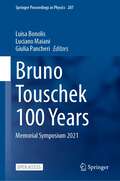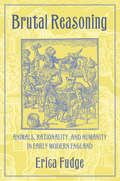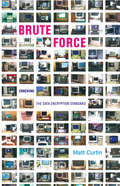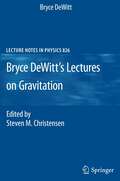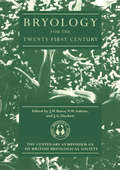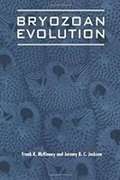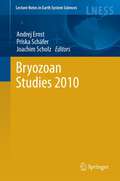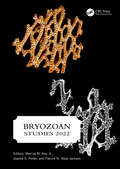- Table View
- List View
Bruno Touschek 100 Years: Memorial Symposium 2021 (Springer Proceedings in Physics #287)
by Luisa Bonolis Luciano Maiani Giulia PancheriThis open access book celebrates the contribution of Bruno Touschek to theoretical physics and particle colliders in Europe. It contains direct testimonials from his former students, collaborators, and eminent scientists, among them, two Nobel Prize winners in Physics, Giorgio Parisi and Carlo Rubbia. It reviews the main developments in theoretical and accelerator physics in the second half of the twentieth century, while at the same time providing an overview of future prospects worldwide. This book is unique in that it will be of interest to historians of physics and also to the younger generation of researchers. Through the contribution of the leading protagonists, the interested scholar will learn about the past, present status, and relevance of both theoretical and experimental accelerator physics. The overview of Bruno Touschek’s life and works across Europe, from pre-war Vienna to Germany, the UK, Italy, and France, adds a human dimension to the scientific narration, while the open access status makes this laudatory book available to anyone with interest.
Bruno Touschek's Extraordinary Journey: From Death Rays to Antimatter (Springer Biographies)
by Giulia PancheriThis book tells the story of a unique scientific and human adventure, following the life and science of Bruno Touschek, an Austrian born physicist, who conceived and built AdA, the first matter-antimatter colliding-beam storage ring, the ancestor of the Large Hadron Collider at CERN where the Higgs Boson was discovered in 2012. Making extensive use of archival sources and personal correspondence, the author offers for the first time a unified history of European efforts to build modern-day particle accelerators, from the dark times of war-ravaged Europe up to the rebuilding of science in Germany, UK, Italy and France through the 1950s and early 1960s. This book, the result of several years of scholarly research work, includes numerous previously unpublished photos as well as original drawings by Bruno Touschek.
Brustkrankheiten im Mammogramm: Diagnostik und pathomorphologische Bildanalyse
by Marton LanyiBlitzschnell im Bild - Mehr als 600 hervorragende Abbildungen - Ausf?rliche Beschreibung der klinischen Symptome - Zusammenfassung der Diagnostik und Therapie - ?er tausend Literatur-Hinweise
Brutal Reasoning: Animals, Rationality, and Humanity in Early Modern England
by Erica FudgeEarly modern English thinkers were fascinated by the subject of animal rationality, even before the appearance of Descartes's Discourse on the Method (1637) and its famous declaration of the automatism of animals. But as Erica Fudge relates in Brutal Reasoning, the discussions were not as straightforward—or as reflexively anthropocentric—as has been assumed. Surveying a wide range of texts-religious, philosophical, literary, even comic-Fudge explains the crucial role that reason played in conceptualizations of the human and the animal, as well as the distinctions between the two. Brutal Reasoning looks at the ways in which humans were conceptualized, at what being "human" meant, and at how humans could lose their humanity. It also takes up the questions of what made an animal an animal, why animals were studied in the early modern period, and at how people understood, and misunderstood, what they saw when they did look.From the influence of classical thinking on the human-animal divide and debates surrounding the rationality of women, children, and Native Americans to the frequent references in popular and pedagogical texts to Morocco the Intelligent Horse, Fudge gives a new and vital context to the human perception of animals in this period. At the same time, she challenges overly simplistic notions about early modern attitudes to animals and about the impact of those attitudes on modern culture.
Brute Force: Cracking the Data Encryption Standard
by Matt CurtinIn 1996, the supposedly uncrackable US federal encryption system was broken. In this captivating and intriguing book, Matt Curtin charts the rise and fall of DES and chronicles the efforts of those who were determined to master it.
Bryce DeWitt's Lectures on Gravitation: Edited by Steven M. Christensen (Lecture Notes in Physics #826)
by Bryce DeWittBryce DeWitt, a student of Nobel Laureate Julian Schwinger, was himself one of the towering figures in 20th century physics, particularly renowned for his seminal contributions to quantum field theory, numerical relativity and quantum gravity. In late 1971 DeWitt gave a course on gravitation at Stanford University, leaving almost 400 pages of detailed handwritten notes. Written with clarity and authority, and edited by his former student Steven Christensen, these timeless lecture notes, containing material or expositions not found in any other textbooks, are a gem to be discovered or re-discovered by anyone seriously interested in the study of gravitational physics.
Bryology for the Twenty-first Century
by Jeffrey W. BatesA compilation of state of the art papers on key topics in bryology from invited speakers at the Centenary Symposium, University of Glasgow, 57 August 1996.
Bryology for the Twenty-first Century
by Jeffrey W. BatesA compilation of state of the art papers on key topics in bryology from invited speakers at the Centenary Symposium, University of Glasgow, 57 August 1996.
Bryophyte Ecology
by A. J. E. SmithThere has been an increasing interest in bryophyte ecology over the past 100 or so years, initially of a phytosociological nature but, additionally, in recent years, of an experimental nature as well. Early studies of bryophyte communities have led to detailed investigations into the relationships between the plants and their environment. Ecological papers, the large number of which is evidenced by the length of the bibliographies in the subsequent chapters, have appeared in numerous journals. Yet, apart from review chapters, by H. Gams and P. W. Richards in Manual of Bryology, edited b:; H. Verdoorn in 1932 and chapters in E. V. Watson's Structure and Life of Bryophytes, Prem Puri's Bryophytes - A Broad Perspective and D. H. S. Richardson's The Biology of Mosses, published in 1972,1973 and 1981 respectively, no general accounts of bryophyte ecology have been published. Although the Bryophyta is a relatively small division of plants, with between 14000 and 21000 species the interest that they have aroused is out of all proportion to the size either of the plants or of the division. It is evident, however, that despite their relative insigni ficance they play an important ecological role, especially in extreme environments and, in the case of bryophytes in tropical cloud forests and of Sphagnum, may even be a dominant factor in the ecology of the area concerned.
Bryozoan Evolution
by Jeremy B. Jackson Frank K. McKinneyThe authors argue that the growth pattern and form of the colony in many bryozoans is an adaptive strategy rather than a stable genetic character. "Bryozoan Evolution is profusely illustrated and has a bibliography of over 400 titles. It will find an appreciative audience of paleontologists, invertebrate zoologists, and ecologists thanks to its innovative and detailed evaluations of the roles of ecology, adaptive and functional morphology, life histories, biomechanics, developmental constraints, and chance on the evolution of the marine taxa of this speciose group."—Russel L. Zimmer, Science "This book is an excellent source of information on the functional morphology and variety of colonial architecture in bryozoans, very well illustrated, and worth reading at least twice."-Robert L. Anstey, Paleobiology "Even as one of the converted, I found the book a stimulating combination of paleobiology and ecology. In many ways it is a 'teaser'-the authors suggest a number of interesting hypotheses, and can test only some of them. Perhaps most important, McKinney and Jackson provide a plethora of fascinating ideas and examples that demonstrate the potential of this group of animals, and that should stimulate more work."-Michael S. Keough, TREE "This stimulating book is sure to promote further interest in bryozoans. It will appeal to biologists and paleontologists alike."-Paul Taylor, Times Higher Education Supplement
Bryozoan Paleobiology (TOPA Topics in Paleobiology)
by Paul D. TaylorBryozoa are among the most abundant yet least understood of phyla in the fossil record. These exclusively colonial animals can be traced back to the Ordovician as fossils and are common elements of sediments deposited in shallow marine environments. On occasion their calcareous skeletons are sufficiently numerous to produce bryozoan limestones. The potential of bryozoans in facies analysis, and their use in macroevolutionary studies, have both been widely recognised, but to date have been incompletely exploited. Bryozoan Paleobiology brings together the scattered research on living and fossil bryozoans in broad and profusely illustrated overview that will help students and researchers alike in understanding this fascinating group of animals. Beginning with the basics of bryozoan morphology, ecology and classification, the book progresses from the smallest scale of skeletal ultrastructure, to the largest of bryozoan distributions in time and space. On the way, topics such as the origin of zooidal polymorphism and macroevolutionary trends in colony forms are covered. Case studies illuminate these topics, and areas in which further research is particularly required are highlighted.
Bryozoan Paleobiology (TOPA Topics in Paleobiology)
by Paul D. TaylorBryozoa are among the most abundant yet least understood of phyla in the fossil record. These exclusively colonial animals can be traced back to the Ordovician as fossils and are common elements of sediments deposited in shallow marine environments. On occasion their calcareous skeletons are sufficiently numerous to produce bryozoan limestones. The potential of bryozoans in facies analysis, and their use in macroevolutionary studies, have both been widely recognised, but to date have been incompletely exploited. Bryozoan Paleobiology brings together the scattered research on living and fossil bryozoans in broad and profusely illustrated overview that will help students and researchers alike in understanding this fascinating group of animals. Beginning with the basics of bryozoan morphology, ecology and classification, the book progresses from the smallest scale of skeletal ultrastructure, to the largest of bryozoan distributions in time and space. On the way, topics such as the origin of zooidal polymorphism and macroevolutionary trends in colony forms are covered. Case studies illuminate these topics, and areas in which further research is particularly required are highlighted.
Bryozoan Studies 2010 (Lecture Notes in Earth System Sciences #143)
by Andrej Ernst, Priska Schäfer and Joachim ScholzBryozoa are a colonial animal phylum with a long evolutionary history, having existed from the early Ordovician (480 My) onward and still flourishing today. Several mass extinctions in earth history shaped and triggered bryozoan evolution through drastic turnover of faunas and new evolutionary lineages. Bryozoa are widespread across all latitudes from Equator to Polar Regions and occur in marine and freshwater environments. They are shaping benthic ecosystems and recording ambient environmental conditions in their skeletons. The book provides a synthesis of the current main topics of research in the field of Bryozoology including combined research on both extant, and extinct taxa. Fields or current research span molecular genetics and phylogeny, life history, reproduction and anatomy, biodiversity and evolutionary patterns in time and space, taxonomy, zoogeography, ecology, sediment interactions, and climate response.
Bryozoan Studies 2022: PROCEEDINGS OF THE NINETEENTH INTERNATIONAL BRYOZOOLOGY ASSOCIATION CONFERENCE (DUBLIN, IRELAND, 22-26 AUGUST 2022)
by Marcus M. Key Joanne S. Porter Patrick N. Wyse JacksonBryozoan Studies 2022 contains nineteen papers presented at the 19th International Conference of the International Bryozoology Association held at Trinity College Dublin in August 2022. Bryozoans are complex and fascinating colonial organisms that range from Cambrian to the present day and which are found in marine and freshwater environments from pole to pole and subtidal to abyssal. Recent tomographic techniques have revolutionised the study of modern and fossil taxa where internal structures are revealed through non-destructive methodologies. Here the internal structure of some Ordovician and Eocene taxa is illustrated through these methods. Phylogenetic studies of bryozoans question the classic classification of the group; here the phylogeny of species from California and Japan is described. Other topics covered are assessments of Recent faunas from Haiti and fossil assemblages from Mexico and the United States. Distributional patterns from the Arctic and New Zealand and the dispersal patterns of bryozoans on rafted pumice and on slipper lobsters are characterised. Further contributions provide descriptions of a rare Permian taxon, clarification of species assigned to the Upper Palaeozoic genus Stenopora, avicularia in Wilbertopora, enigmatic structures in a fenestrate bryozoan, repair structures in trepostomes, and an assessment of skeletonisation in the families of Palaeozoic orders.
Bryozoan Studies 2022: PROCEEDINGS OF THE NINETEENTH INTERNATIONAL BRYOZOOLOGY ASSOCIATION CONFERENCE (DUBLIN, IRELAND, 22-26 AUGUST 2022)
by Marcus M. Key Joanne S. Porter Wyse Jackson, Patrick N.Bryozoan Studies 2022 contains nineteen papers presented at the 19th International Conference of the International Bryozoology Association held at Trinity College Dublin in August 2022. Bryozoans are complex and fascinating colonial organisms that range from Cambrian to the present day and which are found in marine and freshwater environments from pole to pole and subtidal to abyssal. Recent tomographic techniques have revolutionised the study of modern and fossil taxa where internal structures are revealed through non-destructive methodologies. Here the internal structure of some Ordovician and Eocene taxa is illustrated through these methods. Phylogenetic studies of bryozoans question the classic classification of the group; here the phylogeny of species from California and Japan is described. Other topics covered are assessments of Recent faunas from Haiti and fossil assemblages from Mexico and the United States. Distributional patterns from the Arctic and New Zealand and the dispersal patterns of bryozoans on rafted pumice and on slipper lobsters are characterised. Further contributions provide descriptions of a rare Permian taxon, clarification of species assigned to the Upper Palaeozoic genus Stenopora, avicularia in Wilbertopora, enigmatic structures in a fenestrate bryozoan, repair structures in trepostomes, and an assessment of skeletonisation in the families of Palaeozoic orders.
BSL3 and BSL4 Agents: Epidemiology, Microbiology and Practical Guidelines
by Baker Ulrich PrahlIn one handy book, this reference gathers all the necessary information on 14 of the most commonly used dangerous groups of pathogens in biosafety level 3 and 4 laboratories. All the chapters are uniformly structured, with a brief overview of the microbiology, pathology, epidemiology and detection methods for each group. In addition, a whole chapter is devoted to the special biosafety requirements, disinfection, decontamination protocols, accident literature and accident procedures, as well as treatment options for all the organisms. This chapter is clearly marked and easy to find when opening the book. Essential literature for the increasing number of BSL3 or BSL4 labs worldwide and for medical facilities intervening in the case of an incident.
BSL3 and BSL4 Agents: Epidemiology, Microbiology and Practical Guidelines
by Mandy Elschner Sally Cutler Manfred Weidmann Patrick ButayeIn one handy book, this reference gathers all the necessary information on 14 of the most commonly used dangerous groups of pathogens in biosafety level 3 and 4 laboratories. All the chapters are uniformly structured, with a brief overview of the microbiology, pathology, epidemiology and detection methods for each group. In addition, a whole chapter is devoted to the special biosafety requirements, disinfection, decontamination protocols, accident literature and accident procedures, as well as treatment options for all the organisms. This chapter is clearly marked and easy to find when opening the book. Essential literature for the increasing number of BSL3 or BSL4 labs worldwide and for medical facilities intervening in the case of an incident.
BSL3 and BSL4 Agents: Proteomics, Glycomics and Antigenicity
by Jiri Stulik Rudolf Toman Patrick Butaye Robert G. UlrichUnique coverage of proteomic and glycomic approaches to better distinguish highly dangerous pathogens, as well as using these to explore novel treatment and prevention options. The editors and authors are either part of a specialized European network initiated to develop fast and reliable detection and therapy options, or are associated with the core military research complex of the United States. With its description of the methods, their advantages and limitations, as well as the principle outcomes, this is a must-have resource for all professionals dealing with BSL3 and/or BSL 4 agents.
BSL3 and BSL4 Agents: Proteomics, Glycomics and Antigenicity
by Jiri Stulik Rudolf Toman Patrick Butaye Robert G. UlrichUnique coverage of proteomic and glycomic approaches to better distinguish highly dangerous pathogens, as well as using these to explore novel treatment and prevention options. The editors and authors are either part of a specialized European network initiated to develop fast and reliable detection and therapy options, or are associated with the core military research complex of the United States. With its description of the methods, their advantages and limitations, as well as the principle outcomes, this is a must-have resource for all professionals dealing with BSL3 and/or BSL 4 agents.
Bt Resistance: Characterization and Strategies for GM Crops Producing Bacillus thuringiensis Toxins (CABI Biotechnology Series)
by Mario Soberón, Yulin Gao and Alejandra BravoThis book describes the use of Bt crops and the emerging problem of resistance. Covering recent progress in understanding the mechanism of action of Bt toxins, different resistance mechanisms and strategies to cope with resistance in the field, it reviews successes and failures from around the world.
Btec First Applied Science: Principles Of Applied Science Unit 1 Revision Guide
by Jo LockeBtec First Applied Science: Principles Of Applied Science Unit 1 Revision Guide
BTEC First Award Engineering Student Book (PDF)
by Simon Clarke Alan Darbyshire Simon Goulden Christopher Hallgarth Neale WatkinsBTEC First Award in Engineering Student Book - Our BTEC First in Engineering Award Book covers Units 1, 2, 5, 6 7 and 8 so learners have relevant and specific content to complete the new next generation Pearson BTEC First Award in Engineering for level 2 learners. If learners are studying other sizes of this qualification they might prefer our Full Edition*. - Provides all the underpinning knowledge and understanding needed at level 2 to help learners prepare for the course. - Activities in each unit provide support and guidance for learners, and can be used in the classroom or for independent work. - The new BTEC Assessment Zone guides learners through the challenges of both internal and external assessment with grading tips and support for external assessment. * From 2012, Pearson's BTEC First qualifications have been under re-development, so schools and colleges could be teaching the existing 2010 specification or the new next generation 2012-2013 specification. There are different Student Books to support each specification. If learners are unsure, they should check with their teacher or tutor. Units covered: 1: The Engineered World 2: Investigating an Engineered Product 5: Engineering Materials 6: Computer-aided Engineering 7: Machining Techniques 8: Electronic Circuit Design and Construction
BTEC First certificate in Applied Science: Knowledge Book (PDF)
by VariousThe full-colour, interactive Knowledge Book provides each student with: the essential knowledge and understanding of scientific facts and ideas questions, crosswords and word searches to help reinforce their learning advice about building a portfolio of evidence for assessment.
Btec First In Applied Science: Principles Of Applied Science Student Book (PDF)
by Ismail Musa David Goodfellow Sue HockingThis student book supports the level 1/level 2 BTEC First Award in Applied Science - Principles of Applied Science NQF specification for first teaching from September 2012. The book covers all four mandatory units so learners have relevant and specific content to complete the new 2012 award.
BTEC First in Applied Science: revision guide (PDF)
by Jennifer Stafford-BrownResources designed to support learners of the new next generation BTEC First in Applied Science: Principles of Applied Science specification*. This Revision Guide has been specifically written for externally assessed Unit 1: Principles of science in Award 1 of the Level 2 BTEC Firsts in Applied Science. The guide is organised by the assessment structure of the qualification and gives students guidance on the external assessment. Key point summaries of what candidates should know are included to reinforce teaching. Information is presented in a straightforward, user-friendly way. Worked examples, exam questions, revision practice questions and 'test yourself' diagnostic questions prepare students for the exams ahead. In addition, the Revision Guide provides students with all the answers to all the questions in the book. * From 2012, Pearson Education's BTEC First qualifications have been under re-development, so schools and colleges could be teaching the existing 2010 specification or the new next generation 2012-2013 specification. There are different Student Books to support each specification. If learners are unsure, they should check with their teacher or tutor.
